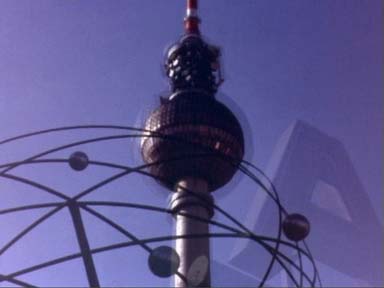|
4-channel
video installation
The animations show instances of the theoretical components of the idea
of ‘roundness’ - dimensions one through four.
The first screen represents one-dimensionality. The radar screen demonstrates
how the one-dimensional form of a line, as it moves in a specific way
over time, describes a circle. The full circle is never present at any
one time. But through persistence of vision, we perceive a complete
circle.
The second screen uses a homage to Rothko to exemplify the circle in
its two-dimensionality. Here, instead of a rectangle, a circular surface
is divided into colour fields. The colours of the background and two
sections are determined by projecting the height of the section onto
the colour-wheel.
The third screen shows the Berlin Television Tower, the ball of the
rotating restaurant representing the circle in its three-dimensional
form. Each frame is, of course, only a two-dimensional representation
of this sphere. But again, through taking many pictures from different
perspectives and animating them, our perception automatically recreates
for us the three-dimensional object.
The fourth dimension is more difficult. Mathematicians may be comfortable
working in four-dimensional geometries, but because of our nature as
prisoners in a three-dimensional world moving in a specific direction
in time, no one can directly perceive a four-dimensional object. Imagination
is therefore necessary. Just as a three-dimensional object casts a two-dimensional
shadow, it is theoretically possible to create a three-dimensional object
which can be interpreted as the ‘shadow’ of a four-dimensional
object. This is a 2D animation created using circles and ‘holes’
which leave a trail as they change size over time.
|

